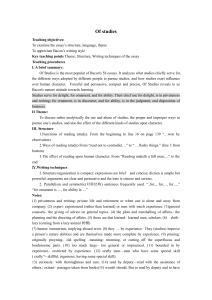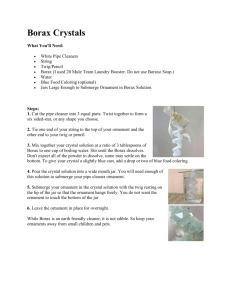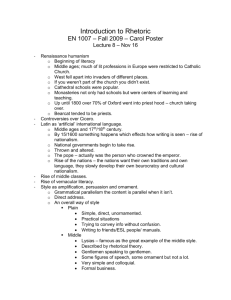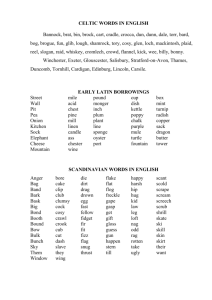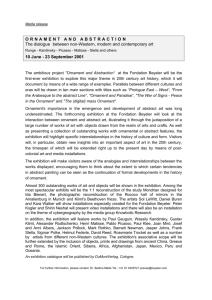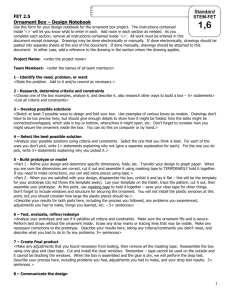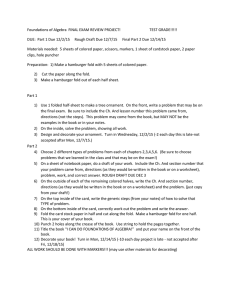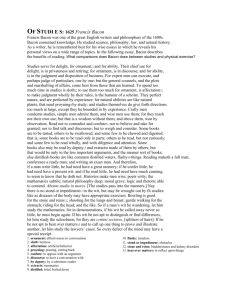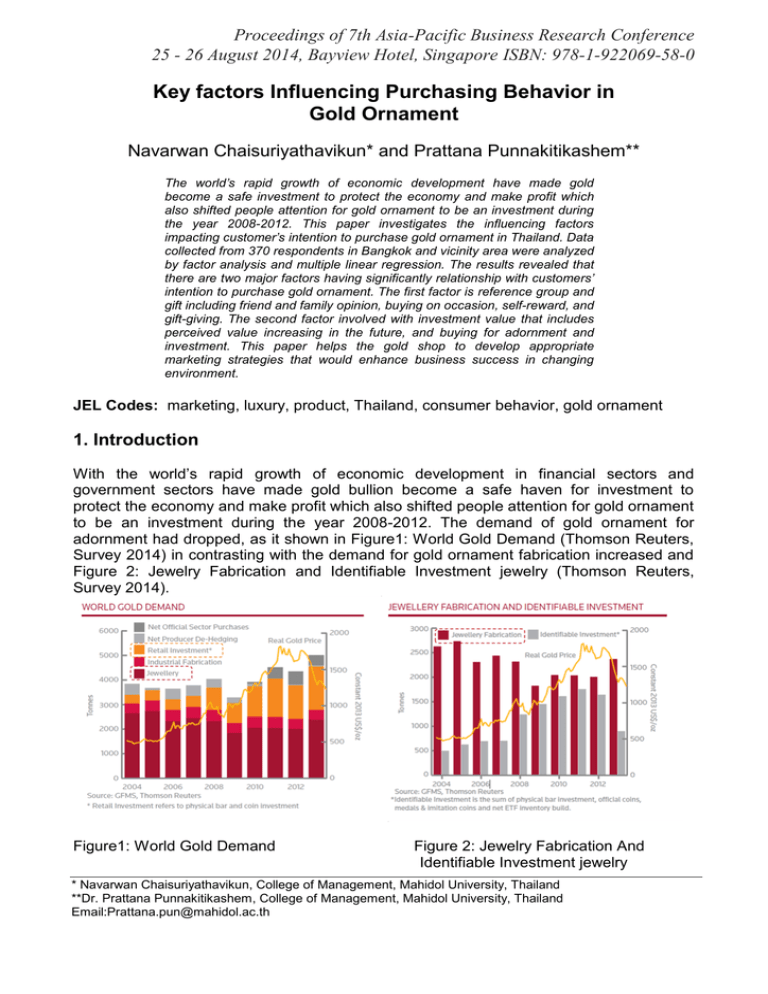
Proceedings of 7th Asia-Pacific Business Research Conference
25 - 26 August 2014, Bayview Hotel, Singapore ISBN: 978-1-922069-58-0
Key factors Influencing Purchasing Behavior in
Gold Ornament
Navarwan Chaisuriyathavikun* and Prattana Punnakitikashem**
The world’s rapid growth of economic development have made gold
become a safe investment to protect the economy and make profit which
also shifted people attention for gold ornament to be an investment during
the year 2008-2012. This paper investigates the influencing factors
impacting customer’s intention to purchase gold ornament in Thailand. Data
collected from 370 respondents in Bangkok and vicinity area were analyzed
by factor analysis and multiple linear regression. The results revealed that
there are two major factors having significantly relationship with customers’
intention to purchase gold ornament. The first factor is reference group and
gift including friend and family opinion, buying on occasion, self-reward, and
gift-giving. The second factor involved with investment value that includes
perceived value increasing in the future, and buying for adornment and
investment. This paper helps the gold shop to develop appropriate
marketing strategies that would enhance business success in changing
environment.
JEL Codes: marketing, luxury, product, Thailand, consumer behavior, gold ornament
1. Introduction
With the world’s rapid growth of economic development in financial sectors and
government sectors have made gold bullion become a safe haven for investment to
protect the economy and make profit which also shifted people attention for gold ornament
to be an investment during the year 2008-2012. The demand of gold ornament for
adornment had dropped, as it shown in Figure1: World Gold Demand (Thomson Reuters,
Survey 2014) in contrasting with the demand for gold ornament fabrication increased and
Figure 2: Jewelry Fabrication and Identifiable Investment jewelry (Thomson Reuters,
Survey 2014).
Figure1: World Gold Demand
Figure 2: Jewelry Fabrication And
Identifiable Investment jewelry
* Navarwan Chaisuriyathavikun, College of Management, Mahidol University, Thailand
**Dr. Prattana Punnakitikashem, College of Management, Mahidol University, Thailand
Email:Prattana.pun@mahidol.ac.th
In the late 2013, the global economic crisis has less impact to the gold price.
The demand
in gold ornament in Thailand is rising up again. Moreover, there are over 6,000 gold
Proceedings of 7th Asia-Pacific Business Research Conference
25 - 26 August 2014, Bayview Hotel, Singapore ISBN: 978-1-922069-58-0
ornament shops in Thailand (Gold Trader Association Thailand, 2014), which mostly run
by family business, all of them need to deal with the situation after the economic had
changed. Today, the demand of Thai people purchase gold ornament in domestic market
is increasing from 14.3 tons to 20.9 tons in the late 2013. It shows in the Figure 3,
(Thomson Reuters, Survey 2014). After the gold consumption has shift back after the
world financial crisis.
Figure 3: Thai Jewelry Fabrication
Therefore, one of the challenges for gold ornament business in Thailand need to do is to
understand the customers’ behavior toward their purchase intention for purchasing gold
ornament. With the aim of knowing more the market condition, and market customer of
gold ornament in Thailand after the time pass by because gold ornament is one type of
luxury product that “Luxury” is particularly defined as a strong element of human
involvement; limited supply and value recognition are the keys components (Cornell 2002,
p.47).
To clarify the characteristic of gold ornament market in Thailand, they consume mostly on
23.16 Karat which equal to 96.5% gold purity to make gold ornaments (Gold Trader
Association Thailand, 2014), with the value of the gold itself have made the gold ornament
consider a luxury good and it also becomes fashion accessory As gold ornament is all
kind of ornaments that include necklace, bracelets, earrings, etc. which design for men,
women, and children which people use it for many purpose (Neeru Jain, 2013)
In this study the respondents that are selected would be at the age 26-45 or above which
the previous research (Kresearch Thailand,2009, Fiscal Policy Office Thailand,2014, Gold
Trader Association Thailand, 2014) shown that these group are the group of people who
are working and have purchasing power to afford goods that are valuable. This research
would help the gold ornament business owner understand more on Thai consumer
behavior, influential factors affecting on Thai customers’ intention to buy gold ornament,
and what the customer preference of purchasing gold ornament in order to develop
appropriate marketing strategies that would enhance business success.
Proceedings of 7th Asia-Pacific Business Research Conference
25 - 26 August 2014, Bayview Hotel, Singapore ISBN: 978-1-922069-58-0
2. Literature Review
Gold ornament is one of the luxury goods which fits to the luxury concept of “refined
enjoyment, of elegance, of things desirable but not essential” (Goody, 2006, p.341);
moreover, jewelry and accessories are also defined as luxury fashion goods which mean
to use or display of a particular branded products bringing prestige to the owner (Gao et
al., 2009). The special feature can be called symbolic and communicative of this group of
products which it also represents the individual’s superiority (Dion, D et al., 2011).
Moreover, it gains higher individual social position which the individual can keep the image
and identity (Penz, E. et al., 2005) by buying and using luxury goods. In addition, gold and
gold ornament have the same aspect of gift identified by (Belk 1979). It included economic
exchange, social exchange, communication, and social connection which have an effect
on consumers’ purchasing intention.
2.1 Consumer Segmentation
The common criteria that we need to know are age, gender, education, occupation to see
who buy who purchase gold ornament, which the customers buy for, how men and women
think of gold ornament. Age: is a factor which can determine motivation, interest, and
perception (Engel,1993). A different age group has different needs and wants (Engel,
1993), interest, purchase, and behavior (Sheth et al., 1999). From the past research
(Kresearch Thailand,2009, Fiscal Policy Office Thailand,2014, Gold Trader Association
Thailand, 2014) found out that a potential group of customer who buy start from the age
above 25 year old because they start to work and seek out form goods that can represent
themselves which shape this research to focus on consumer who at the age above 25
year old.
2.2 Consumer Perception and Consumer Behavior
Consumer Perception
Perception can be clarified as a person pay attention to product or service, bought or
searched to the consumer sense (Walters, 1989). It also can be concluded in the sensory
input which information receives from skin, tongue, nose, ears, or eye. Moreover,
consumer can also affected by many different channels on how they perceived (Antonides
et al., 1998). When an individual chooses, arranges, and interprets stimuli to be logical
and meaningful is defined as perception (Schiffman et al., 2004). There are three basic
dimensions of consumer’s perception which are exposure, perceptive selection, and
interpretation (Schiffman et al., 2005).
Consumer Behavior
It consists of tangible and intangible dimension which include good or service, mental
process, beliefs and values. In addition consumer behavior refers to an individuals
involved in using products and services with decision process that include individual
decision whether what, where, when, how from the buying goods and services (Engil et
al., 1982), ideas and experiences to satisfy themselves in term of needs and desires
(Kotler, 1999).
2.2.1 Understand consumer perception
From the previous research shown the key driver in jewelry shopping, perception of goods
are qualities, the brand, the sale person, the store, the influencer and etc. (Jokinen,2011)
which effect on the consumers’ intention to purchase. Retailing mix is a combination 6Ps –
Product, Price, Place, Promotion, Personal, and Presentation- to retailer to seek out the
great way to put factors to target market (Levy, 2012).
Proceedings of 7th Asia-Pacific Business Research Conference
25 - 26 August 2014, Bayview Hotel, Singapore ISBN: 978-1-922069-58-0
Retailing Mix (Product, Price, Place, Promotion, Personal, and Presentation)
Brand, Product, and Quality are three important factors of jewelry; however, the way to
build perception is consumers need information. For jewelry buying consumers in the
marketing luxury wealth, there is a research shown that when they do not know a good
thing about the product, the information of the product becomes necessary (Mitchman and
Mazze, 2006). The gold ornament product attribute is also involve level of quality with
which can build trust (Sanguanpiyapana and Jasper, 2009).
Product: is shape, line, and everything that can be seen of the product toward the brand
which including package in order to attack customers (Frings, 2005). People who are
fashion consciousness get attacked with the design with attractive style including other
attribute such as packaging, product design, merchandise display, and etc. can get the
shopper can stimulate the sale immediately (Donovan & Rossier, 1982; Verplanken &
Herabadi, 2001).
Quality: Consumers tend to find the trusted sell representative and avoid a buying
channel that unreliable (Jokinen, 2011). In Thailand the Gold ornament stores need to be
certified and register with the Ministry of Commerce, Thailand and Gold Trader
Association, Thailand which can guarantee to the consumer. However, there are other
factors to be count to build trust as well such as the product need to be 96.5% gold purity.
Price: Products can be exchanges by money; moreover, the price is a main factor for
buyer to select the product (Kotler, 2000). Nonetheless, customers always compare the
price they bought the last time with the next purchase of the same brand base on their
perception. Therefore, buyers evaluate products’ quality by using price as an indicator
(Lichtenstein et al., 1993). According to Kotler (2000), pricing structure has five base
aspects: Price discount and allowance, Promotional pricing, Geographical pricing,
Discriminatory pricing, and Product-mix pricing. In gold ornament, the buyers are price
sensitive and like to bargain for discount (Aiello et al. 2009).
Place: the company made product available to the consumers at where they convenience
to purchase. Moreover, the distributors, wholesalers, and retailers are involved as
distribution network which can serve the customers easy to purchase (Kotler, 2000).
Jewelry customer may normally and likely buy the jewelry at the traditional stand-alone
shop at the main road (Aiello et al. 2009).
.
Promotion: it involves all activities which the companies communicate to the market
(Kotler, 2000). Any form of transforming information of products and services to engage
and remind the potential customers (Walters and Bergiel, 1989). In order to create an
interest of a new product, promotional tactic can be applied to keeping positive brand
images and increase purchasing intention (Graeff, 1995). Marketing communication mix
has five measure tools: Advertising, Sale promotion, Sale promotion, Public relation
involve, Personal selling, and Direct marketing (Kotler, 2000).
Sale representative: Personal as sale representative has a high effect on the customers’
perception which now big retailers have trained their sale staffs (Hill 2007) in order to be
able to explain the materials, quality of products that can influence the customers which it
makes the perception of sale representative become very important. Trust is the most
important point for the customers to purchase or not to purchase (Jokinen, 2011).
According to the pervious of customer about what the customers want, the customers
want to feel and touch the product, get information about the product and be able to ask
the seller, whereas, the seller should give a good experience to the customer such as
Proceedings of 7th Asia-Pacific Business Research Conference
25 - 26 August 2014, Bayview Hotel, Singapore ISBN: 978-1-922069-58-0
helpful to the customers, unanticipated for the bargaining price and etc. (Arnold et al.
2005).
Presentation as store atmosphere: the store environment has significant impact to the
customers which can stimulate and make the customer enjoyable with better chance of
impulsive buying (Donovan and Rossiter, 1982; 1994). When the customers are exiting, it
reduces possibility to think before action. The stimulation in the shop can be increased by
sounds (Holbrook and Anand, 1990), aromas (Mattila and Wirtz, 2008), or colors (Valdez
and Mehrabian, 1994). By building a harmonious atmosphere and environment to the
store can help increasing the sale volumes (Laakso 2004, p.57).
2.2.2 Understanding Consumer behavior
It is the opportunity for the company to understand consumer behavior, so they can
predict demand, and find the way to serve the customers better. In this study would be
more on the psychology, marketing and consumer mind (Antonides et al., 1998). This
approach of buying need is emphasis motivation on hedonic responses and symbolic
meaning which affect people intention to buy goods and services. It involves with. The
external influence factors affect consumer behavior is culture, social, personal, and
physiological that involve in consumer decision making. In this research will focus on the
reference group and personal value which directly and indirectly effect on the consumer
behavior. As the culture is the deepest influence on consumer behavior; however, every
person need to use himself instinct to make decision (Kotler et al., 2002).
2.3 Motivation
Motivation is a canter of consumer behavior that can draw individual’s action (Antonides
and Raaij, 1998). As there are two theories: Karl Jung’ approach refer to collective
subconscious that give an opportunity for a company to work with image and symbol
(Arnould et al. 2004) of the brand and product, whereas, in Abraham Maslow’s hierarchy
of needs involve with physiology, safety and security, social needs, self-esteem, and selfactualization (Arnould et al 2004). However, in gold ornament adornment, it matches with
a stage social need and self-esteem which makes gold ornament is not a basic need to
people (Jokinen, 2011). People wear gold ornament for individual’s self-image and use it
to show others people for social recognition; moreover, the purchase situation is also
involved with the consumer behavior. However, the previous show that wearing jewelry is
just like wearing clothes which jewelry can build a strong tool for self-image that affect how
individual think of one self to project to the others (Jokinen, 2011).
Moreover, from the theory, there are seven motivations for the consumption in luxury
goods which are self-actualization, social comparison, other's influence, investment for
future, buying for special time, buying out of emotion and gift-giving (Wang, Sun and
Song, 2012). However, in this study would only focus on self-image, other's influence
investment for future, buying for special time, gift-giving, reference group, hedonic value,
and utilitarian value.
2.3.1 Self-concept
The concept of self and symbolic value, it link to the symbolic value if good that individual
buys (Grubb and Grathwohl 1967). The self-concept push the consumers to symbolize
themselves by goods (Kassarjian 1971; 413). From the research it shown a strong degree
that self-concept drive consumer behavior (Grubb and Grathwohl 1967; Grubb and Hupp
1968; Kassarjian 1971; Landon 1974; Munson and Spivey 1980; Schenk and Holman
1980; Sirgy 1982; Solomon 1983; Belk 1988; Lee 1990).
Self-concept has impact consumer intention to buy. People also use gold as a symbol
regardless the demographic and social class. Other benefits apart from products are
Proceedings of 7th Asia-Pacific Business Research Conference
25 - 26 August 2014, Bayview Hotel, Singapore ISBN: 978-1-922069-58-0
determined as symbol (Solomon et al., 1987). People try to express themselves in,
satisfaction of social need, prestige, higher status, and other viewpoints that can drive
other people perception of their possessions (Belk, 1982); moreover, it drive attention to
create a sense of self (Campbell, 1996). When people purchase and consume goods are
seen that have personal and social meaning from the function of goods or services,
moreover, it link to symbolic of personal attributes, goals, and social status (Levy, 1959).
2.3.2 Self-image
There is an impact of self and ideal self-image on purchasing intention of consumer. The
actual self-image is a one’s perception of what he or she like, while ideal self-image is a
way that one would like to be (Schenk and Holman 1980). From the past research show
that actual-self and ideal-self has correlated. However, someone might clarify for a higher
self-image for his or her purchase intention (Schenk and Holman 1980). In the identity
research by Lee (1990), the self-image situation can be defined as symbolic interaction
theory which refers to individual wishes other to have oneself (Schenk and Holman 1980;
2). Therefore, it create the assumption of one has many selves that can be express
through many situation depend on social role and social position. When one decides on
particular image to express a social position which use particular good and service to refer
to one’ status (Burcak, 2003)
Gold ornament always comes to people attention, when each one looks at the others to
evaluate that person. Moreover, gold ornament is a tool to build and reflect self-image
(Jokinen, 2011). To study how the customers perceive the gold ornament product, it
needs to know what the condition that they buy is. Some of the research shown that 56%
customer purchases it as a gifts (Aiello et al. 2009).
2.3.4 Investment
When people buy luxury good for future investment which the goods themselves
increasing their value (Wang, Sun and Song, 2012). Consumer are pay attention to the
value in the future that can give them return as exchange. In addition, consumer purchase
gold ornament as an investment needs security as well.
2.3.5 Buying for special occasion and gift-giving
consumer buys gold ornament for special occasion such as festival and holiday to use as
social needs including gift-giving which people purchase gold ornament as a luxury gift for
others because they can maintain a good relationship with their social group (Wang, Sun
and Song , 2012). From the previous research, the precious jewelry has more subjective
features than objective features in the buying behavior (Jamal and Goode 2001), as nonfunctional motives and functional motives (Sanguanpiyapana and Jasper 2009),for
example, when a buyer buy gold ornament for a brand she know as a gift for herself or
someone else because she want to keep the image. Gold ornament include an aspect of
gift identify which cover on socialization, communication, economic value, social exchange
(Belk, 1979), social connection (Wailendorf and Amould 1988), and rites of passages
(Noble and Walker 1997).
Proceedings of 7th Asia-Pacific Business Research Conference
25 - 26 August 2014, Bayview Hotel, Singapore ISBN: 978-1-922069-58-0
2.3.6 Reference group
One of the important factors that would affect customers would be culture differences
which are individualism and collectivism. Individualism is societies benefited to the
individuals that group called individualistic; however, if it benefit to the community which
prefer group profits to the advantage of the members, it called collectivism society
(Hofstede, 2004). In collectivism, the social relation between people exchanging
information is important to secure their purchasing decision (Argo et al., 2005). Reference
groups means groups of people that one relate to which can influence their decision
(Pickton and Broderick 2005). People in this group include family, friends, and colleagues
are the important influencer: both parties engage the process of perception (Kotler et. al.,
2002). This refers to socialization, for example, some family husband may dominate
decision making but some may not, or friend might encourage doing thing.
2.3.7 Hedonic and Utilitarian value
When people purchase goods and services which not only customers are satisfied by
physical function, but also other intangible attributes (Babin et al., 1994). The purchase of
hedonism motivate are involve in guilty feeling, enjoyment, multi-sensory, fantasy, (Okada,
2005) which can justify the experience of the consumer. On the other hand, when people
buy goods or services for function, it only refers to the necessary task that is utilitarian
value (Okada, 2005). On the other hand, the utilitarianism is for function benefits which
care more on objective quantifiable. The utilitarian products are about the believing in
products, feeling like or dislike about the product function, and intention to buy the
products or services (Maria, 2012).
2.4 Purchase Decision
When people making decision in the academic dimension there are five aspects
(Arnould et al 2004, p272) which are:
Economic utility maximizing: return maximization
Cognitive decision making: problem solving stage
Experimental or hedonic: self-experiment
Behavioral influence: environmental effect on individual
Meaning transfer: individual obtain components to complete individual’s life story
From the previous research in European country, the customers care much about product,
design and price (Vicenzaoro First, 2010). It is important to understand when the customer
making decision in order to purchase.
Precious jewelry is high involvement product which need people take longer time to
make decision before buying (Taavi, 2008). When the product is risky and expensive, it
involve high level of self-expression which make consumer need to investigate the good
thing that suit with them before make a purchase (Kotler et. al., 2002)
3. The Methodology
For this research paper, the quantitative research used as a tool to discover Thai
consumer at the age above 25 years old would have intention to purchase gold ornament.
The quantitative research has been used as a tool to study target respondents in order to
understand them better about the impact of factors influencing consumer behavior and
purchasing intention, the researchers have often use quantitative research to measure the
construct and hypotheses (Jokinen, 2011). The quantitative method is used quantify
behavior toward gold ornament purchasing intention of for Thai consumers’ age above 25
Proceedings of 7th Asia-Pacific Business Research Conference
25 - 26 August 2014, Bayview Hotel, Singapore ISBN: 978-1-922069-58-0
years old. The benefits of using quantitative research are to see the reliability of data and
real important factor that influence consumer.
In this research is used questionnaire survey which is questions that gain information from
respondents. The question divided into 2 sections: the first section was measure
demographic information in gender, age, and income. In addition, this section part
includes many purposes in purpose of buying, location, and frequency. The second
section was used 4 main independents variables including marketing mix and quality, sale
person and store atmosphere, reference group, and motivation to measure consumer
purchasing intention. Lastly, measuring Thai consumers who age above 25 years old
purchasing intention to purchase gold ornament as dependent variable is included. This
research use five point 5-point Likert scale, from 5 (strongly agree), 4 (Agree), 3 (neutral),
2 (disagree), and 1(strongly disagree).
3.1 Data Collection
The questionnaire was distributed through people in Bangkok and vicinity during 2014.
400 questionnaire was distributed by using both papers and online. The online survey
method is used by Googledoc.com survey (101 respondents). Only 370 questionnaires
were returned, the response rate is 92.5%
3.2 Data Analysis
To analysis data, this research uses Statistical Package for Social Sciences (SPSS)
program software version 20.0 to test to test the constructs that has been testing and
reviewing related to topic of factor affecting consumer behavior and purchase intention for
gold ornament. The measurement for this research includes descriptive analysis, one-way
ANOVA, factor analysis, reliability, correlation, and multiple linear regression.
4. The Findings
4.1 Demographic research exploration
As the survey was collected from various ways, Table 1 can be illustrated the respondent
demographic characteristic as gender, age, income, where they shop, and frequency.
Table 1: Demographic profile of the respondents
Demographic
Gender
Age
Male
Female
Total
Number
of Percentage
respondents
(%)
126
34.1
244
65.9
370
100.0
26 - 30 years old
31- 35 years old
36- 40 years old
41- 45 years old
More than 46 years old
Total
132
80
50
48
60
370
35.7
21.6
13.5
13.0
16.2
100.0
Proceedings of 7th Asia-Pacific Business Research Conference
25 - 26 August 2014, Bayview Hotel, Singapore ISBN: 978-1-922069-58-0
Table 1: Demographic Profile of the Respondents (Cont.)
Demographic
Income
Less than 10,000 Baht
10,000 – 20,000 Baht
20,001 – 30,000 Baht
30,001 – 40,000 Baht
40,001 – 50,000 Baht
More than 50,001 Baht
Total
Number
of Percentage
respondents
(%)
45
12.2
109
29.5
84
22.7
24
6.5
47
12.7
61
16.5
370
100.0
According to Table 1, it illustrated that there were male 126 respondents and female 244
respondents from the total of 370 respondents which can be calculated as male 34.1%
and female 65.9%.
According to the age range, the respondents were divided into 5 groups. which illustrated
that 132 respondents (35.7%) at the age 26 – 30 years old, 80 respondents (21.6%) at the
age of 31-35 years old, 50 respondents (13.5%) at the age of 36-40 years old, 48
respondents (13.0%) at the age 41-45 years old, and 60 respondents (16.2%) at the age
more than 46 years old were reply this survey.
In addition, the range of respondents’ income illustrated that 45 respondents (12.2%) have
income less than 10,000 baht per month, 109 respondents (29.5%) have income around
10,001 – 20,000 baht, 84 respondents (22.7%) have income around 20,001 – 30,000
baht, 24 respondents (6.5%) have income around 30,001 – 40,000 baht, 47 respondents
(12.7%) have income around 40,001 – 50,000 baht, and 61 respondents (16.5%) have
income more than 50,001 baht 80 respondents (21.6%) at the age of 31-35 years old, 50
respondents (13.5%) at the age of 36-40 years old, 48 respondents (13.0%) at the age
41-45 years old, and 60 respondents (16.2%) at the age more than 46 years old were
reply this research.
4.2 Factor analysis
Factor analysis is a tool to grouping similar variable as factors which information can be
summarized into meaningful aspect (KvantiMOTV, 2009). The factor analysis is use for
market research in term of market segmentation, investigate brand aspect, understand
consumer behavior, and etc. (Malhotra and Birks 2007, p.648).
There are two main purpose of running factor analysis which is to explore factors with
number and quality of factor in order to identify and measure new factors, and to test set
of variable that it significant or not (KvantiMOTV, 2009) “This coefficient’s values are
typically between 0 and 1, when 0,6 or less is considered unsatisfactory” (Malhotra and
Birks 2007, p.358 citing Cronbach 1951).
In order to determine factor that would significant, this research use factor loading is a
correlation between original variable and factor, assessing cutting of value which less than
0.4 (Hair et al. 2006, p.129). Eigenvalue needs to be more than 1 because it measures
variance in each variable which shows the level of contribution (Garson 2009). Moreover,
to define appropriate number of factors, Scree plot tells number of factor that suitable for
the analysis (Garson 2009).
Proceedings of 7th Asia-Pacific Business Research Conference
25 - 26 August 2014, Bayview Hotel, Singapore ISBN: 978-1-922069-58-0
Table 2: Factor Analysis of factors Influencing Purchasing Behavior in Gold Ornament
Rotated Component Matrixa
Component
1
2
3
4
5
6
35.I buy similar gold ornament design
.843
with my friend.
36.My friends' opinions affect my gold
.828
ornament purchase behavior
34.I always ask my friend opinion before I
.787
buy gold ornament
Reference Group
37.My family ' opinion affects my gold
.604
and Gift
ornament purchase behavior.
27.I buy gold ornament for special
.597
occasions.
29.I often buy gold ornament as gifts for
.587
others.
28.I often buy gold ornament as gifts for
.416
myself.
22.I wear gold ornament for adornment
.768
myself to look better.
Self-Image
32.Gold ornament is for body adornment.
.736
23.I buy gold ornament for my status
.693
appearance.
30.I feel happy when I wear gold
.676
ornament.
8.I am willing to pay for the design of the
.806
gold ornament I like.
7.I choose gold ornament because I like
Product Design
.802
the design..
9.Gold ornament should represent current
.751
fashion.
10.Gold ornament should be durable.
.682
18.It is important that I trust the sale
.840
person.
19.Sale person can influence me to buy
.828
Sale person and
gold ornament.
Store Atmosphere
20.I buy gold ornament most likely when
there is a pleasant atmosphere in the
.699
store.
24.I buy gold ornament because I believe
their values will increase in the future and
.875
Investment Value
buying.
25.Gold ornament is a way of investment
.846
for me.
33.I buy gold ornament because it can
.652
easily convert to money.
14.I like to bargain for gold smith charge
.817
Price
discount.
15.I am satisfied with price discount for
.762
gold smith charge.
Extraction Method: Principal Component Analysis.
Rotation Method: Varimax with Kaiser Normalization.
a.
Rotation converged in 6 iterations.
Proceedings of 7th Asia-Pacific Business Research Conference
25 - 26 August 2014, Bayview Hotel, Singapore ISBN: 978-1-922069-58-0
In this research showed 6 dimensions which can be regroup after the factor analysis
explore in rotated component matric. The new factors can be illustrated as below:
1. Reference group and Gift: which are relevant to friend and family opinion before
buying gold ornament, buying on occasion, and gift-giving.
2. Self-image: wearing gold for adornment, face and status, and self-happiness
3. Product design: attractive design of fashion and durable can attract consumers.
4. Sale person and Store atmosphere: can create trust for consumer
5. Investment value: gold ornament is one type of investment as consumers’ perceive
value increase in the future.
6. Price: bargaining and price discount
Combining new variables and defining the correlation with dependent variable which is
consumer purchasing intention for gold ornament. The result of the factor analysis shown
some of the variables were cut because of the insignificant level (Hair et al., 2006).
4.3 Multiple Linear Regression Analysis
Multiple linear regression analysis use to predict about individual value which can be
describes relationship between two or more variable (Hair et al., 2006). After the factor
analysis shown the regroup of significant factors factor analysis which reference group
and occasion, self-image, product design, sale person and store atmosphere, investment
value, and price tested with Thai consumers’ buying behavior toward gold ornament
purchasing intention. The decision of accepting or rejecting the hypothesis of the statistical
test based on 95% confidential interval which P-value is less than 0.05 level of significant
in order to avoid errors (Garson 2009).
Table3: Model of factors Influencing Purchasing Behavior in Gold Ornament
Model Summary
Model R
R
Adjusted R Std. Error Change Statistics
Square Square
of
the R Square F
df1
Estimate Change Change
.293a .086
1
.071
1.258
.086
5.697
6
df2
Sig.
F
Change
363
.000
a. Predictors: (Constant), Reference Group and Gift, Self-Image, Product Design, Investment Value,
Seller and Store, Price
Table 4: Regression Model of factors Influencing Purchasing Behavior in
Gold Ornament
Coefficientsa
Model
1
Unstandardized
Coefficients
B
Std. Error
1.459
.549
(Constant)
Reference Group and
.273
Gift
Self-image
.081
Product Design
-.141
Investment value
.214
Seller and Store
.018
Price
.012
Standardized t
Coefficients
Beta
2.656
Sig.
.103
.198
2.661
.008
.102
.105
.108
.098
.091
.062
-.079
.113
.011
.009
.798
-1.346
1.983
.184
.134
.426
.179
.048
.854
.894
.008
a. Dependent Variable: 38.I intention to buy gold ornament in the next 12 month
From the linear regression result for gold ornament purchasing intention as dependent
variable with group of independent variable (Reference group and Gift, Self-Image,
Proceedings of 7th Asia-Pacific Business Research Conference
25 - 26 August 2014, Bayview Hotel, Singapore ISBN: 978-1-922069-58-0
Product design, Investment value, Seller and store atmosphere, and Price). Table 3
illustrated the adjusted r square of 7.1%. Table 4 showed the two constructs which had
positive relations with Thai consumers who age above 25 years old purchasing intention to
buy gold ornament. There are two constructs which are reference group and gift, and
investment value. Reference group and gift has 0.008 significant which less than 0.05
level of significant rate, and standardized coefficients (Bata) of 0.198. In addition,
Investment value construct has 0.048 significant which less than 0.05 level of significant
rate, and standardized coefficients (Bata) of 0.118. It indicated that the Reference group
and gift, and Investment value significantly influence Thai consumers (age above 25 years
old) purchasing intention toward gold ornament.
5. Summary and Conclusions
This paper addresses influential factors affecting on Thai customers’ intention to buy gold
ornament. In this study was to test about Thai consumer at the age above 25 years old
toward gold ornament purchasing intention. An exploratory of factor analysis was a tool to
test the constructs and to test the compound variables and reliability of each scale. Data
were tested by using linear regression method.
370 respondents which were 126 males and 244 females participated in this study. The
majority age groups were 26 - 30 years old and 31- 35 years old for 132 respondents, and
80 respondents respectively with the income around 10,000 – 30,000 baht. Traditional
store and Shopping mall store were the channel that the respondents purchase gold
ornament which can be calculated (45.7%) and (47.0%) respectively. In addition, majority
of the respondents were answer that they purchased gold ornament 1 - 2 times a year
(59.5%). The factors had significant relationship were reference group and gift –which
included friend and family opinion, buying on occasion, self-reward, and gift-giving-, and
investment value –which include perceive value increase in the future, and buying for
adornment and investment because gold ornament can convert to money. The most
influential factor to purchase gold ornament was friend, family, and relative.
This research would help the gold ornament business owner understand more on Thai
consumer behavior, influential factors affecting on Thai customers’ intention to buy gold
ornament, and what the customer preference of purchasing gold ornament in order to
develop appropriate marketing strategies that would enhance business success.
References
Aiello, G. Donvito, R. Godey, B. Pederzoli, D. 2009. An international perspective on luxury
brand and country-of-origin effect. Journal of Brand Management. London.
Antonides, G. Raaij, W.F. 1998. Consumer Behavior – A European Perspective. John
Wiley and Sons Ltd. Chichester, England. 619p.
Arnould, E. Price, L. Zinkhan, G. 2004. Consumers. McGraw-Hill Companies Inc. New
York.
Arnold, M.J. Reynolds, K.E. Ponder, N. Lueg, J.E. 2005. Customer delight in a retail
context: investigating delightful and terrible shopping experiences. Journal of Business
Research, Volume 58, Issue 8, August 2005, p.1132-1145.
Belk, Russell (1979), "Gift-Giving Behavior," Research In Marketing, Vol. 2, ed Jagdish
Sheth, Greenwich, CT: JAI Press, 95-126.
Proceedings of 7th Asia-Pacific Business Research Conference
25 - 26 August 2014, Bayview Hotel, Singapore ISBN: 978-1-922069-58-0
Belk, 1982. “Effects of Gift Giving Involvement on Gift Selection Strategies.”Advances in
Consumer Research (9): 408-412.
Belk, W. Russell. 1988. “Possessions and the Extended Self.” Journal of Consumer
Research 15(September): 139-168.
Campbell, Collin. 1996. “The Meaning of Objects and The Meaning of Actions,” Journal of
Material Culture (1): 93-105.
Cornell, Andres. 2002. ―Cult of luxury: The new opiate of the masses.‖ Australian
Financial Review, 27th April: 47.
Dion, D. And Arnould, E., Retail Luxury Strategy: Assembling Charisma through Art and
Magic, Journal of Retailing, 87 (4), 502–520 (2011)
Donovan, R.J. and Rossiter, J.R. (1982). Store Atmosphere: An Environmental
Psychology Approach. Journal of Retailing, 58:1, 34-57.
Engel, James F. and Roger D. Blackwell (1982), Consumer Behavior, 4th ed., Hinsdale,
IL: The Dryden Press.
Fiscal
Policy
Office
http://www.fpo.go.th/SI/Source/Training/training2/training2_2.htm
Thailand,2014
Frings, G. S. (2005), “Fashion: From Concept to Consumer (8th Ed.)”, New Jersey:
Pearson/Prentice Hall.
Gold
Trader
Association
Thailand,
http://goldtraders.or.th/Research/GRC/grc_report08-05-13.pdf
2013
Gold Trader Association Thailand, 2014
Goody, J., 2006. From misery to luxury. Social Science Information 45 (3), 341–348.
Gao, L., Norton, M.J.T., Zhang, Z., To, C.K, 2009. Potential niche markets for luxury
fashion goods in China. Journal of Fashion Marketing and Management 13 (4), 514–526.
Grubb, Edward L. and Grathwohl, Harrison L. 1967. “Consumer Self-Concept, Symbolism,
and Market Behavior: A Theoretical Approach.” Journal of Marketing 31 (October): 22-27.
Hill, M. 2007. Toughen Up – Surviving your business throught tough times.
Holbrook, M. B. and Anand, P. (1990). Effects of Tempo on Responses to Music.
Psychology of Music, 18, 150-162.
Jokinen Henri, 2011, Consumer Perceptions and Behavior in Respect toEthical, Social,
and Environmental Matters in Jewellery Business
Kassarjian, H. Harold. 1971. “Personality and Consumer Behavior: A Review.”
Journal of Marketing Research 8(November): 409-418.
Proceedings of 7th Asia-Pacific Business Research Conference
25 - 26 August 2014, Bayview Hotel, Singapore ISBN: 978-1-922069-58-0
Kotler, Philip.(1999).Gary Armstrong "Principles of Marketing" translates Ali Parsaeian,
Tehran, Press Adabestan
Kresearch
Thailand,2009
https://www.kasikornresearch.com/th/keconanalysis/pages/ViewSummary.aspx?docid=24175
Laakso, H. 2005. Brädit kilpailuetuna (Brands as source of competitiveness). Talentum.
Hämeenlinna. Finland. 385p.
Landon, E. Laird. 1974. “Self-Concept, Ideal Self Concept, and Consumer Purchase
Intentions.” Journal of Consumer Research 1(September): 44-51.
Lee, H. Dong. 1990. “Symbolic Interactionism: Some Implications for Consumer SelfConcept and Product Symbolism Research.” Advances in Consumer Research (17): 386393.
Levy, J. Sidney. 1959. “Symbols for Sale.” In Dennis Rook eds., Brands, Consumers,
Symbols & Research. Thousand Oaks: Sage.
Levy and Weitz, Retailing Management, 8th edition, McGraw-Hill/Irwin, 2012.
Lichtenstein, D.R., Ridgway, N.M., & Netemeyer, R.G. (1993), “Price perceptions and
consumer shopping behavior: a field study”, Journal of Marketing Research, Vol.30
No.2, pp. 234-45.
Mitchman, R. D. Mazze, E.M. 2006. The affluent consumer. Marketing and Selling the
Luxury Lifestyle. Praeger. Westport. London. 194p.
Munson, J. Michael and Spivey, W. Austin. 1980. “Assessing Self-Concept.”Advances in
Consumer Research (7) eds., Jerry Olson, Ann Arbor:Association for Consumer
Research.
Neeru Jain, 2013, Consumer Buying behavior with Regard to Branded and Traditional
Jewellery with special reference to Jaipur jewellery market
Penz, E., and Stottinger, B., Forget the "real" thing-take the copy! An explanatory model
for the volitional purchase of counterfeit products, Advances in Consumer Research, 32
(1), 568-575 (2005)
Sanguanpiyapana, T. Jasper, C. 2009. Consumer insights into luxury goods: Why they
shop where they do in a jewelry shopping setting. Journal of Retailing and Consumer
Services. Volume 17, Issue 2, March 2010. p.52-160.
Schenk, T. Carolyn and Holman, H. Rebecca. 1980. “A Sociological Approach to Brand
Choice: The Concept of Situational Self Image.” Advances in Consumer Research (7):
610-614.
Schiffman, L.G., & Knauk, L. L. (2004), “Consumer behavior (8th Ed)”, Upper Saddle
River, NJ, Prentice Hall.
Sirgy, M. Joseph. 1982. “Self-Concept in Consumer Behavior: A Critical Review.”
Journal of Consumer Research, 9(December): 287-300.
Proceedings of 7th Asia-Pacific Business Research Conference
25 - 26 August 2014, Bayview Hotel, Singapore ISBN: 978-1-922069-58-0
Solomon, R. Michael. 1983. “The Role of Products as Social Stimuli: A Symbolic
Interactionism Perspective.” Journal of Consumer Research 10(December):319-329.
Solomon, and Henry Assael. 1987. “The Forest or the Trees? A Gestalt Approach to
Symbolic Consumption,” In Jean Umiker-Sebeok, eds., Marketing andSemiotics.
Berlin: de Gruyter, pp. 189-218.
The cover of GFMS Gold survey 2014 features Japan’s Fujiyama covered with Gold Grain
Switzerland’s Metterhorn
Valdez P. and Mehrabian, J.(1994). Effects of Colour on Emotions. Journal of
Experimental Psychology: General, 123, 4, 394-409.
Verplanken, B. & Herabadi, A. (2001), “Individual Differences in Impulse Buying
Tendency: Feeling and No Thinking”, European Journal of Personality, 15, Special Issue
on Personality and Economic Behavior, S71–S83.
Walters, C. G., & Bergiel, B. J. (1989), “Consumer Behavior: A Decision-making
approach”, Cincinnati, OH: South-Western Publishing.
Wang, Ying, Sun, Shaojing and Song, Yiping (2012) "Chinese Luxury Consumers:
Motivation, Attitude and Behavior." Journal of Promotion Management.


